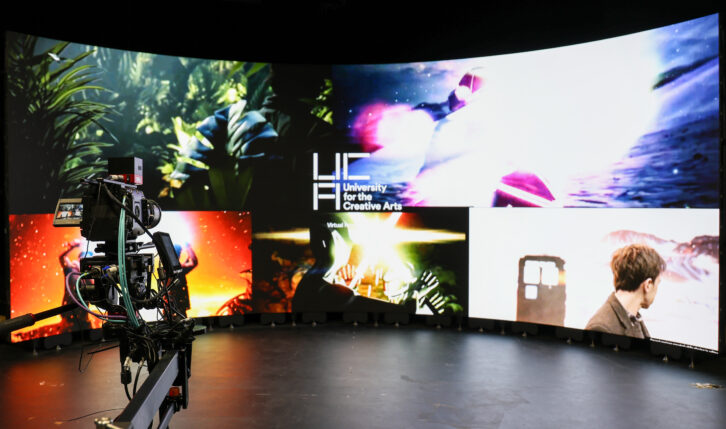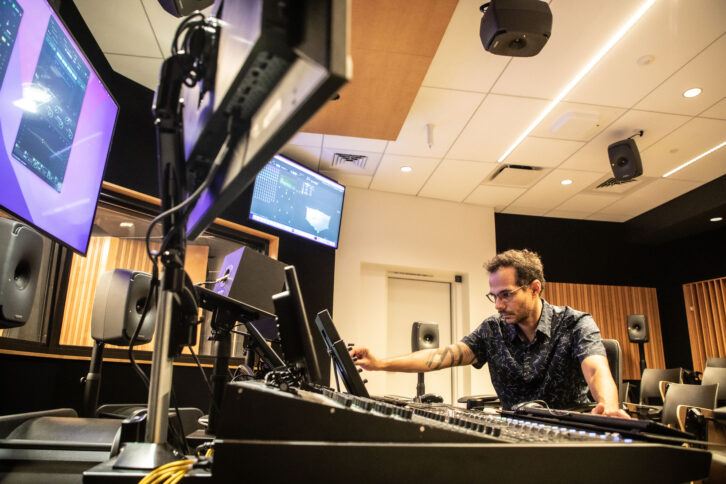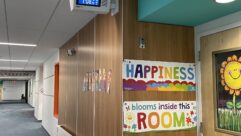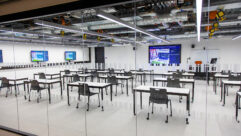
Emerging technology systems for virtual production. immersive audio, and eSports are on a fast track for many educational institutions.
University for the Creative Arts: Virtual Production
The University for the Creative Arts (UCA) in Farnham, UK wanted a comprehensive virtual studio setup. The brand-new installation supplied by CJP Broadcast Service Solutions, and fitted out in conjunction with ATG Danmon, has taken an existing large studio at UCA’s Farnham campus and transformed it with a large LED volume at one end and a motion capture stage at the other.
The LED volume consists of a curved wall, 8m x 3m, together with a ceiling panel of 4.5m x 2m. Both use INFiLED panels installed by Bendac and driven by Brompton processors: the wall is 2.6mm pitch LED, the ceiling 3.9mm. CJP made a bespoke curved lighting bar to match the shape of the wall, to ensure real elements of virtual productions are best lit.
The studio uses an existing Blackmagic camera, which has now been fitted with the Mo-Sys StarTracker system to ensure precise location in three-dimensional space. The Mo-Sys VP Pro XR software, which incorporates the Unreal graphics engine, provides the realtime virtual output to the volume.
Using an existing green screen at the other end of the studio, CJP implemented a 20 camera Vicon motion capture installation, ideally suited for character animation in games. The whole studio was also fitted out with Kino Flo hard and soft lights as part of the turnkey CJP project.
“With this new installation our games and film production students have access to the very best in professional tools, so they can give full rein to their creativity and be ready to move into the global creative industries,” said Professor Simon Macklin, Deputy Vice-Chancellor at UCA. “CJP took us through every aspect of this project, showing us how we could use the same facilities the best professionals use. They supplied, installed and trained us on it all, and their continuing support is valued by us hugely.”
“We now have a huge amount of experience in delivering advanced facilities for corporate and education users, so they can benefit from broadcast quality facilities and workflows,” says Christopher Phillips, managing director of CJP Broadcast Service Solutions. “The exciting part of the UCA installation was their focus on games creation, hence the motion capture facilities for realistic character animation.
“What we also ensured was that the studio space is completely flexible, so it can be used as a virtual studio including realtime set extensions, for motion capture, and of course as a conventional studio,” he added. “This is a remarkable resource.”
University of Sunderland: Virtual Production
Elsewhere in the UK, CJP completed cutting edge installations at the University of Sunderland for media production students. The projects include a remarkable LED volume virtual production environment as well as a green screen stage, an HD studio and outside broadcast facilities.
The University of Sunderland already has an excellent reputation for the quality of its courses in media, with its film production syllabus regarded as the best in the UK (2023 Guardian University Guide). It offers courses in performance as well as production and aims to offer a professional environment in which students can develop their skills. Courses are based in the David Puttnam Media Centre: Lord Puttnam not only gives his name but also regularly offers masterclasses and tutorials.
“Our job is first to enthuse our students with a love for production and performance, and second to ensure their career prospects are as strong as possible when they graduate,” said Nicholas Glean, senior lecturer in video and new media. “Our students can go to producers who may still be nervous around virtual and augmented reality studios and other new techniques and say ‘I’ve done this – look at my showreel’. Getting real, extended hands-on experience is hugely important.”
 Over recent years, CJP has implemented four major projects for the university. First came the refurbishment of an existing green screen studio, replacing legacy equipment which had largely been donated by broadcasters with modern virtual studio systems. Recognizing sustainability as a major concern, the project included installing an LED lighting rig to replace power-hungry legacy lamps.
Over recent years, CJP has implemented four major projects for the university. First came the refurbishment of an existing green screen studio, replacing legacy equipment which had largely been donated by broadcasters with modern virtual studio systems. Recognizing sustainability as a major concern, the project included installing an LED lighting rig to replace power-hungry legacy lamps.
CJP upgraded the campus production studio to HD, using largely Ross equipment including Xpression graphics and a Carbonite switcher. It also provided a comprehensive four-channel outside broadcast package, allowing students to build complete news workflows with live inserts from any location.
The last stage of the project is the Virtual Production stage, featuring a 10m x 3.5m LED volume. Allied with the StarTracker Studio from Mo-Sys, which combines multiple camera tracking with powerful real-time photorealistic graphics based on the Unreal engine, this is an impressively large stage, allowing students and other users to create scenes only limited by their imaginations.
“We have worked with the University of Sunderland to achieve what they need to be the leaders in their field,” said Christopher Phillips, managing director of CJP. “But even more important, we have helped them link everything up with real-world workflows. The whole production center mirrors the way the best modern professional centers work.”
The university’s Nicholas Glean added, “Thanks to CJP, we are the first to be able to offer courses on virtual and augmented production in our own facilities, aimed at film and television. Working together, we have created a working and teaching environment which is roundly integrated: these are not isolated technologies, but all directed to production. During the process, the team at CJP has opened the door for our staff and students to meet other people and vendors in the industry, expanding our contacts to enrich our offering and extend our outreach into the community locally, nationally and globally.”
Butler University: eSports
In the heart of Indianapolis, Butler University is transforming into an epicenter for Esports, having just opened the doors to its new Esports Park with a supporting broadcast and live streaming infrastructure.
Originally established as a student-led initiative in 2017, Butler University has helped foster its students’ passion for Esports and gaming into an opportunity for players to grow academically, competitively, and professionally. It has since transformed into a flagship location for the sport and one of the most competitive programs in the country with Butler’s varsity Esports teams competing in the BIG EAST Conference, in both Rocket League and League of Legends.
Butler’s new first-of-its-kind Esports Park is a 7,500-square-foot, multi-use facility featuring approximately 40 gaming PCs, gaming consoles, a virtual reality area, café, and community office spaces. The space offers gameplay memberships, access for corporate training, youth STEM events and Esports camps.
This state-of-the-art facility connects members of the Esports community and broadcasts games using NewTek’s iconic TriCaster, 3Play, and PTZ products.
“Our facility required adaptable livestream technology which was easy to understand and use. This was especially important given our efforts to host various livestream competitions while also providing students with hands-on production experience and learning opportunities,” says John Lacheta, Butler University’s Manager of Facilities and Operations.
 Butler University decision-makers chose the NewTek TriCaster TC1 video production platform and NewTek 3Play 3P1 sports video production solution, and three NewTek NDI|HX PTZ2 cameras, which enabled the studio to easily extend its live production capabilities.
Butler University decision-makers chose the NewTek TriCaster TC1 video production platform and NewTek 3Play 3P1 sports video production solution, and three NewTek NDI|HX PTZ2 cameras, which enabled the studio to easily extend its live production capabilities.
The production team used the TriCaster to connect and switch between the multiple cameras being used to film its competitions. Additionally, all TriCasters are IP-enabled using the NDI standard, which allows users to connect devices such as cameras, microphones, intercoms, and lighting through Ethernet cabling and provides two-way communication. The TriCaster allowed the production team to easily connect and manage camera switching while improving the studio production efficiency.
“The flexibility of this system allows us to support a plethora of events of different shapes and sizes. The agility of the NDI standard plays a massive role in how we can shift from classroom to open play and live event modes quickly and with intent,” says Nathan Duke, Manager of Esports Programs and Facility Operations, Butler Esports, said.
“Given that we host so many high-profile Esports events, it was necessary for us to have the technology that could easily ingest a magnitude of virtual signals and tie them all into a network quality product for our fans and players. TriCaster with NDI did just that.”
The Sidney Poitier New American Film School at Arizona State University: Immersive Audio
Just as emerging visual technologies expand curriculum for students, immersive audio is another important frontier. The Media and Immersive eXperience (MIX) Center, home to The Sidney Poitier New American Film School at Arizona State University (ASU), saw the opening of novel facilities last fall at its Mesa, AZ location, seven miles from the University’s main Tempe campus. The new 118,000-square-foot, state-of-the-art facility, located within the Herberger Institute for Design and the Arts, hosts The Poitier Film School’s 750 undergraduate film majors. The Poitier Film School offers students a curriculum in film and media production and filmmaking practices, as well as enabling students to earn a four-year degree in film with access to industry standard production facilities and equipment.
The emphasis on audio at the facility is made clear by how much of it is dedicated to sound: three main studios focused on mixing, ADR/scoring, and foley, are all equipped with immersive Dolby 7.1.4 Atmos systems. The main mix control room, which is also a 25-seat classroom, is capable of 3rd-order ambisonics monitoring. There are also three 5.1-surround-capable audio editing rooms, three 30-seat computer labs, and sixteen video edit bays with three of those focused on color grading, as well as a color grading classroom. What ties all of these advanced educational and production spaces together is audio monitoring from Genelec. The components were sourced through the Burbank, California-based firm ALT Systems, who were also involved with the installation and calibration of the systems.
In every room, from the 7.1.4 spaces to the stereo-oriented video editing rooms, active monitoring creates a sonically consistent environment. For instance, the three largest mixing rooms use Genelec 8351B Smart Active Monitors as their L-C-R array and 8341As for the surrounds and overheads, with a pair of 7370A subwoofers. The 5.1 audio-editing studios and two video-forwarded computer labs, which are heavily used for film, tv, streaming, game design, and a diverse set of student projects, each use five 8330A monitors and a 7360A subwoofer. The audio-forwarded computer lab has a 7.1.4 Dolby Atmos set with additional side and overhead monitors. The color grading and QC classroom is Atmoscapable. The video editing bays are set up for 7.1, and the rest are configured for stereo monitoring — All with a combination of Genelec 8020D, 8030C, and 8040B monitors, plus 7360A subs.
“I’ve been using Genelec monitors for about two decades. Monitoring choices can be a matter of personal taste, but here we needed a near-field monitoring solution that we not only trusted but also could apply as seamlessly as possible to the entire facility, that could quickly switch between monitor combinations and configurations that our projects might call for. We operate a complete post-production workflow, from editing, sound, color, to quality control and final delivery (mastering), all considering immersive formats such as Dolby Atmos. For this reason, we needed to make sure that any project that had to move between rooms in the facility had a consistent sonic experience. For student projects and group activities, the wider and more natural sweet spot experience that the concentric configurations of Genelec’s “The Ones” models provide us is also a helpful educational tool. Whether our students are designing sounds or mixing for film, streaming platforms, games or XR experiences, we want to make sure that they develop listening skills throughout the process,” says Prof. Rodrigo Meirelles, Clinical Assistant Professor of Sound Design/Film and Media at The Poitier Film School at ASU.
 It goes beyond monitors, though. The Genelec Loudspeaker Manager (GLM) software platform was used, in conjunction with Genelec’s AutoCal 2 calibration algorithm, to automatically measure and manage how the monitors and subwoofers are installed and positioned in each room. But that technology was taken even further, becoming part of the facility’s educational mission. Meirelles points out that “using GLM, we can graphically demonstrate to students what EQ calibration curves in a space look like and the effect that room acoustics have on monitor placement – and vice versa. At the push of a button, we can let them hear what a monitor sounds like when it’s tuned for the room it’s used in. And since it is software-based, we can show them how the process works on the screen.”
It goes beyond monitors, though. The Genelec Loudspeaker Manager (GLM) software platform was used, in conjunction with Genelec’s AutoCal 2 calibration algorithm, to automatically measure and manage how the monitors and subwoofers are installed and positioned in each room. But that technology was taken even further, becoming part of the facility’s educational mission. Meirelles points out that “using GLM, we can graphically demonstrate to students what EQ calibration curves in a space look like and the effect that room acoustics have on monitor placement – and vice versa. At the push of a button, we can let them hear what a monitor sounds like when it’s tuned for the room it’s used in. And since it is software-based, we can show them how the process works on the screen.”










